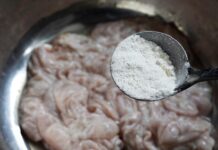Pregnant women often share a curious tip — using litmus paper to determine if their water has broken. Let’s explore this intriguing topic in today’s article!
1. Is Amniotic Fluid Leakage During Pregnancy Dangerous?

Amniotic fluid leakage can be a serious warning sign during pregnancy. It may increase the risk of uterine and fetal infections and even lead to miscarriage. Additionally, within 24 hours of amniotic fluid leakage, a pregnant woman may go into labor.
Other associated risks include:
- Oligohydramnios (low amniotic fluid) can result in birth defects, fetal distress, or, more severely, preterm labor or stillbirth.
- Increased risk of chorioamnionitis (infection of the amniotic fluid, membranes, or placenta), sepsis (blood infection), and neonatal infections.
- Cord prolapse, where the umbilical cord exits the cervix before the baby.
- Higher likelihood of cesarean delivery and premature birth.
- If amniotic fluid leakage occurs in the second trimester, it can lead to preterm labor and miscarriage.
2. How to Use Litmus Paper to Test Amniotic Fluid Leakage
What is Litmus Paper?

Litmus paper is a type of paper that has been impregnated with a mixture of ethanol or water and a dye derived from lichens. The dye originally has a purple color, giving the paper its distinctive name.
Litmus paper is commonly used to test the pH of a solution or to determine the acidity or alkalinity of a substance based on the color change it exhibits:
- If the solution is alkaline, the litmus paper will turn blue.
- If the solution is acidic, the litmus paper will turn red.
- If there is no color change, the solution is neutral.
How to Use Litmus Paper to Test Amniotic Fluid Leakage

To use litmus paper to test for amniotic fluid leakage, follow these steps:
- Wash and dry your hands thoroughly.
- Prepare a piece of litmus paper.
- Use a cotton swab to collect vaginal discharge and apply it to the litmus paper.
- Compare the color displayed on the litmus paper to the color chart, which is numbered from 1 to 14.
Interpreting the Results:
- If the litmus paper does not change color, the fluid is likely urine.
- If the litmus paper turns blue, it indicates amniotic fluid leakage.
3. Precautions When Using Litmus Paper to Test Amniotic Fluid Leakage

According to experts, vaginal discharge in women is typically acidic, while amniotic fluid is alkaline. Using low-quality litmus paper or incorrect testing methods can lead to a misdiagnosis of ruptured amniotic fluid, which is extremely dangerous. If you intend to use litmus paper for this purpose, opt for medical-grade litmus paper and avoid products of unknown origin to prevent potential harm to your body.
Additionally, it is advisable to perform the test in the morning, before eating or drinking anything, to obtain more accurate results. Vaginal infections can also affect the accuracy of the test results.
4. Where to Buy Litmus Paper for Testing Amniotic Fluid Leakage?

Litmus paper is readily available in the market for various purposes, including education, experiments, and medical use. To purchase litmus paper suitable for testing amniotic fluid leakage, visit pharmacies or medical facilities at hospitals to ensure you obtain medical-grade litmus paper.
In this article, we explored the use of litmus paper to test for amniotic fluid leakage, a topic that has gained attention among expectant mothers. Hopefully, you now understand how to use litmus paper for this purpose and are aware of the precautions to ensure your well-being.
Source: Hellobacsi.com
What is a Trimester? Everything You Need to Know About the Stages of Pregnancy.
The trimesters are the three distinct phases of a pregnancy. Each trimester marks a unique stage in the development of the fetus, and understanding these trimesters is essential for expecting mothers to ensure a healthy pregnancy journey. Stay tuned as we delve into the world of trimesters and unravel their significance in a mother’s and baby’s life.
Pregnant Women: What to Eat and What to Avoid for a Healthy Pregnancy
Pregnancy is an exciting yet delicate time, and it’s crucial for expecting mothers to be cautious about their diet. Our article today reveals the foods to avoid during pregnancy to lower the risk of miscarriage. We aim to provide valuable insights to help expecting mothers navigate their dietary choices and ensure a healthy journey towards motherhood.



































